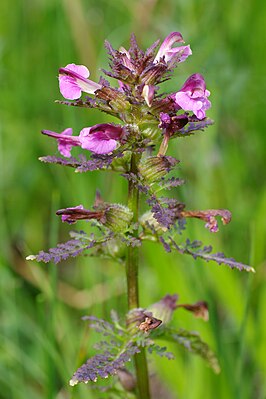Marsh louse weed
| Marsh louse weed | ||||||||||||
|---|---|---|---|---|---|---|---|---|---|---|---|---|

Marsh louse weed ( Pedicularis palustris ) |
||||||||||||
| Systematics | ||||||||||||
|
||||||||||||
| Scientific name | ||||||||||||
| Pedicularis palustris | ||||||||||||
| L. |
The marsh louse herb ( Pedicularis palustris ) is a type of plant from the genus of the lice herbs ( Pedicularis ).
description
Vegetative characteristics
The marsh lice herb is an annual or biennial to perennial herbaceous plant and reaches heights of 15 to 40 centimeters. The hollow, upright stem is only slightly branched.
The opposite leaves are divided into a short petiole and a leaf blade. The double pinnate leaf blade is oblong with a length of up to 8 centimeters in outline.
Generative characteristics
The pink to purple flowers are arranged individually in leaf and stem axils and form an ear . The hermaphrodite flowers are zygomorphic with a double flower envelope; the crown slightly twisted. The calyx is bloated. The upper lip is unsplit, ending in a hood shape and almost sickle-shaped, the lower lip is three-lobed.
The bilateral capsule fruit is spherical to ovoid and opens upwards. The dark brown seeds are up to 2.4 millimeters long.
The number of chromosomes is 2n = 16.
Similar species
There is a possibility of confusion with the forest lice herb , which is only branched at the bottom and has lying stems.
ecology
The marsh lice herb is an annual winter annual to two-year therophyte or hemicryptophyte . It is a swamp plant and a semi-parasite .
From an ecological point of view, it is a homogamous "real lip flower". The flowers are horizontal and therefore require a high learning ability for the correct approach of the insects, which is why one speaks of an "intelligence flower". In order to get to the nectar secreted by the discus , the bumblebees, as pollinators , have to push apart the opening of the corolla tube, which is only 0.5 mm wide; under this aspect one speaks of a "power flower". First the scar is touched. As the head penetrates deeper into the flower, the dry pollen is scattered. Bumblebees can only get to the nectar ("nectar robbery") by biting the corolla tube from the side ("nectar robbery"), as their proboscis are only 7 to 9 millimeters long. The flowering period extends from June to July.
Since the dry stem is elastic and the sepals act as wind and raindrop catchers, the swamp lice herb is a wind spreader and a raindrop ballist. Less often, it also acts as an animal spreader when animals roam past and become entangled. The swamp lice herb is a light germ. The fruit ripeness extends from August to October.

Occurrence and endangerment
The swamp louse herb is common in Europe between northern Europe , northern Italy and the Urals . It is also found in Kazakhstan, Asian Russia, northern Mongolia and China. It prefers low and intermediate moors as well as wet meadows . It is a Scheuchzerio Caricetea fuscae class of character in Central Europe , which occurs mainly in Caricion lasiocarpae societies.
In the Allgäu Alps it rises in the Kleiner Walsertal at the Ifersgundalpe and at the Schwarzwasserhütte to an altitude of 1700 meters.
In Germany, the marsh louse weed is endangered and is particularly protected under the Federal Species Protection Ordinance (BArtSchV).
Systematics
The first publication of Pedicularis palustris was in 1753 by Carl von Linné . A synonym of Pedicularis palustris L. is Pedicularis palustris subsp. serotina Squivet .
From Pedicularis palustris there are several subtypes:
- Pedicularis palustris L. subsp. palustris
- Pedicularis palustris subsp. borealis (JWZetterst.) Hyl. : It occurs in Norway , Sweden , Finland in northern Russia and on the Faroe Islands .
- Pedicularis palustris subsp. karoi (Freyn) Tsoong (Syn .: Pedicularis karoi Freyn ): It occurs in Russia, Mongolia and China.
- Pedicularis palustris subsp. opsiantha (Ekman) Almq. (Syn .: Pedicularis opsiantha Ekman ): It occurs in Western, Northern, Central, Southeastern Europe and Turkey .
literature
- Werner Rothmaler : Excursion flora from Germany - vascular plants: basic volume. Heidelberg, Berlin, 1999. ISBN 3-8274-0912-8 .
- Ruprecht Düll , Herfried Kutzelnigg : Pocket dictionary of plants in Germany and neighboring countries. The most common Central European species in portrait. 7th, corrected and enlarged edition. Quelle & Meyer, Wiebelsheim 2011, ISBN 978-3-494-01424-1 .
Individual evidence
- ↑ a b Erich Oberdorfer : Plant-sociological excursion flora for Germany and neighboring areas. 8th edition, Stuttgart, Verlag Eugen Ulmer, 2001, ISBN 3-8001-3131-5 . P. 860.
- ↑ a b Yang Han-bi; Noel H. Holmgren, Robert R. Mill: Pedicularis Linnaeus. - Same text online as the printed work , In: Wu Zheng-yi, Peter H. Raven, Deyuan Hong (Ed.): Flora of China. Volume 18: Scrophulariaceae. Science Press and Missouri Botanical Garden Press, Beijing and St. Louis 2010
- ↑ Erhard Dörr, Wolfgang Lippert : Flora of the Allgäu and its surroundings. Volume 2, IHW, Eching 2004, ISBN 3-930167-61-1 , p. 474.
- ↑ a b c d Karol Marhold, 2011: Scrophulariaceae : Datasheet Pedicularis palustris In: Euro + Med Plantbase - the information resource for Euro-Mediterranean plant diversity.
Web links
- Pedicularis palustris L., marsh louse weed. In: FloraWeb.de.
- Pedicularis palustris subsp. palustris L., swamp louse weed (subspecies). In: FloraWeb.de.
- Pedicularis palustris subsp. opsiantha (Ekman) Almquist, swamp lice herb (subspecies). In: FloraWeb.de.
- Marsh louse weed . In: BiolFlor, the database of biological-ecological characteristics of the flora of Germany.
- Profile and distribution map for Bavaria . In: Botanical Information Hub of Bavaria .
- Pedicularis palustris L. In: Info Flora , the national data and information center for Swiss flora . Retrieved March 19, 2016.
- Distribution in the northern hemisphere according to Eric Hultén
- Thomas Meyer: Lice herb data sheet with identification key and photos at Flora-de: Flora von Deutschland (old name of the website: Flowers in Swabia ).
